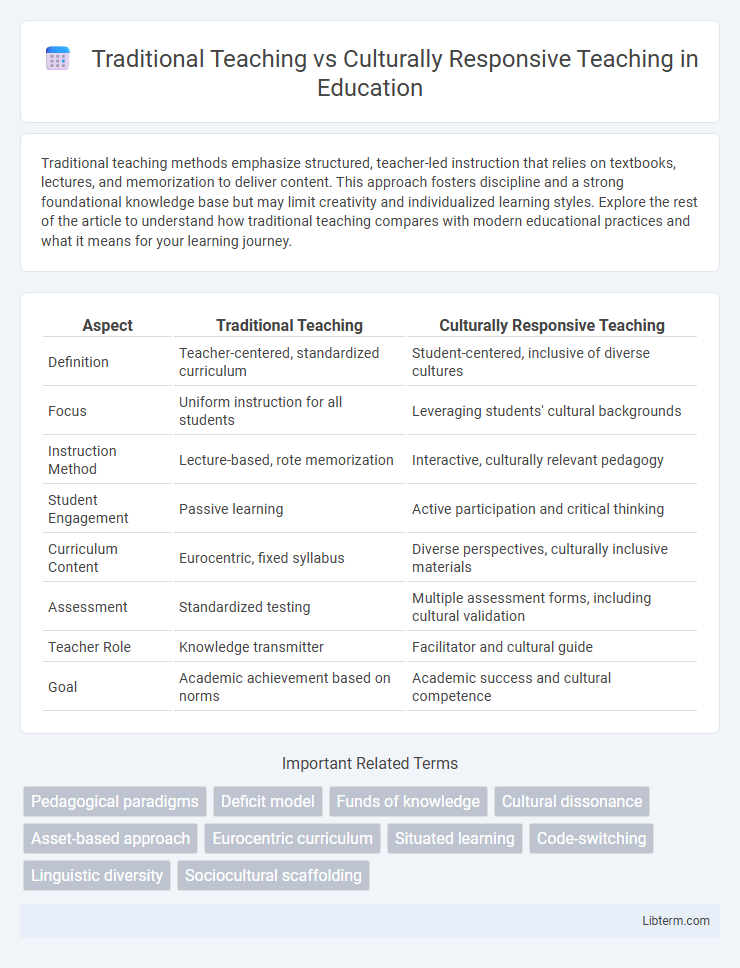Traditional teaching methods emphasize structured, teacher-led instruction that relies on textbooks, lectures, and memorization to deliver content. This approach fosters discipline and a strong foundational knowledge base but may limit creativity and individualized learning styles. Explore the rest of the article to understand how traditional teaching compares with modern educational practices and what it means for your learning journey.
Table of Comparison
| Aspect | Traditional Teaching | Culturally Responsive Teaching |
|---|---|---|
| Definition | Teacher-centered, standardized curriculum | Student-centered, inclusive of diverse cultures |
| Focus | Uniform instruction for all students | Leveraging students' cultural backgrounds |
| Instruction Method | Lecture-based, rote memorization | Interactive, culturally relevant pedagogy |
| Student Engagement | Passive learning | Active participation and critical thinking |
| Curriculum Content | Eurocentric, fixed syllabus | Diverse perspectives, culturally inclusive materials |
| Assessment | Standardized testing | Multiple assessment forms, including cultural validation |
| Teacher Role | Knowledge transmitter | Facilitator and cultural guide |
| Goal | Academic achievement based on norms | Academic success and cultural competence |
Understanding Traditional Teaching Methods
Traditional teaching methods emphasize teacher-centered instruction, relying heavily on lectures, rote memorization, and standardized assessments to measure student learning outcomes. These approaches often prioritize uniform content delivery across diverse classrooms, potentially neglecting students' cultural backgrounds and unique learning needs. Understanding this foundation highlights the contrast with culturally responsive teaching, which adapts pedagogy to include students' cultural contexts and experiences for more inclusive education.
Defining Culturally Responsive Teaching
Culturally responsive teaching is an educational approach that recognizes and incorporates students' cultural backgrounds, experiences, and perspectives into the learning process to enhance engagement and academic success. Unlike traditional teaching, which often follows a standardized curriculum and teaching methods, culturally responsive teaching adapts content and instructional strategies to reflect diverse cultural contexts and promotes inclusivity. This method leverages students' cultural knowledge as a foundation for learning, fostering a more meaningful and relevant educational experience.
Historical Context of Educational Approaches
Traditional teaching methods emerged during the Industrial Revolution, emphasizing standardized curricula, teacher-centered instruction, and uniform assessment to prepare students for factory-like work environments. Culturally responsive teaching developed in the late 20th century as a response to the growing diversity in classrooms, focusing on integrating students' cultural backgrounds into the learning process to enhance engagement and academic success. This approach challenges the historical norms of assimilation in education by validating multicultural identities and promoting equity.
Classroom Dynamics: One-Size-Fits-All vs. Inclusive Practices
Traditional teaching often employs a one-size-fits-all approach, where uniform instruction disregards diverse cultural backgrounds and learning styles. Culturally responsive teaching adapts classroom dynamics to include students' cultural references, promoting engagement and validation of identities. This inclusive practice fosters equity, making learning environments more dynamic and supportive for all students.
Student Engagement and Motivation
Traditional teaching often uses uniform instructional methods that may not align with diverse student backgrounds, resulting in lower engagement and motivation. Culturally responsive teaching integrates students' cultural references into lessons, enhancing relevance and promoting higher participation. Research indicates that culturally responsive strategies increase student motivation by making learning more meaningful and accessible.
Cultural Representation in Curriculum
Traditional teaching often employs a standardized curriculum that predominantly reflects Western cultural norms, limiting diverse cultural representation and student engagement. Culturally responsive teaching integrates multiple cultural perspectives, enabling students from varied backgrounds to see their identities and experiences reflected in the learning material. This approach fosters inclusivity, enhances cultural awareness, and promotes academic success by validating students' cultural context within the educational environment.
Teacher-Student Relationships and Cultural Awareness
Traditional teaching often emphasizes a one-size-fits-all approach that may overlook individual cultural backgrounds, leading to less personalized teacher-student relationships. Culturally responsive teaching prioritizes understanding students' cultural contexts, fostering stronger connections and trust between teachers and students. This approach enhances cultural awareness in the classroom, promoting inclusivity and improved academic engagement.
Assessing Learning Outcomes and Equity
Traditional teaching methods often rely on standardized assessments that may not account for diverse cultural backgrounds, potentially limiting equity in evaluating student learning outcomes. Culturally responsive teaching incorporates assessment strategies that reflect students' cultural contexts, promoting fairness and a deeper understanding of their academic progress. By aligning evaluation with students' lived experiences, culturally responsive approaches enhance equity and provide more accurate measures of learning outcomes across diverse populations.
Challenges and Barriers to Implementation
Traditional teaching often faces challenges such as a one-size-fits-all curriculum that neglects diverse cultural backgrounds, leading to disengagement and achievement gaps among students. Culturally responsive teaching encounters barriers including limited teacher training, lack of institutional support, and resistance to changing conventional pedagogical methods. Successfully implementing culturally responsive strategies requires addressing systemic biases and investing in professional development tailored to diverse educational settings.
Future Trends in Culturally Responsive Education
Future trends in culturally responsive education emphasize integrating technology and personalized learning to enhance cultural relevance in diverse classrooms. Schools increasingly adopt adaptive curricula that reflect students' cultural backgrounds, fostering inclusivity and academic engagement. Research highlights the growing role of educator training programs to equip teachers with skills for implementing culturally sustaining pedagogies effectively.
Traditional Teaching Infographic

 libterm.com
libterm.com